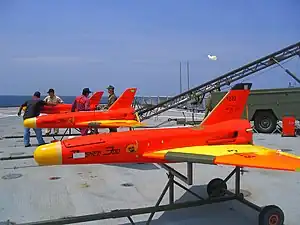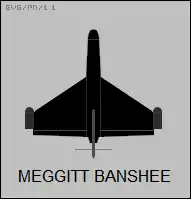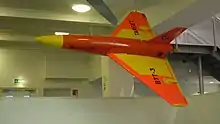| BTT3 Banshee | |
|---|---|
 | |
| A team of Royal Brunei Armed Forces military and civilian contractors prepare "Banshee" unmanned drones for launch from the U.S. Navy's dock landing ship USS Fort McHenry (LSD 43). | |
| Role | Target Drone |
| National origin | United Kingdom |
| Manufacturer | Meggitt Defence Systems |
| First flight | 1983 |
| Introduction | 1984 |
| Status | In service |
| Primary user | Worldwide |
| Number built | Over 8000[1] |
| Developed into | SAGEM Crecerelle |
The BTT3 Banshee, formerly the Target Technology Banshee & Meggitt Banshee, is a British target drone developed in the 1980s for air defence systems training.
Design and development
The Banshee was developed by Target Technology Ltd.[2] The company had been specialising in lightweight engines for drones and had developed its own design in 1983.[3]
Banshee is a built mostly out of composite material (Kevlar and glass-reinforced plastic) with a tailless delta wing planform. The first models used a 26 hp 342 cc Normalair-Garrett two-cylinder two-stroke driving a pusher propeller. Performance was 35 to 185 knots (65 to 343 km/h; 40 to 213 mph) with an endurance from one to three hours. Flight control is by two elevons.
Operational history
Banshee entered service with the British Army in the mid-1980s as an aerial target for the Short Blowpipe and Javelin shoulder-launched missiles.[6]
Banshee has been deployed in over 40 Countries.[7] It has been tested against Blowpipe, Chaparral, Crotale, Javelin, Phalanx, Rapier, Hisar (including Hisar O+ and Siper), Sea Sparrow, QRSAM, Akash SAM (including Akash-NG) and Barak 8 SAM systems.[8]
Operators
Variants
- Banshee 300 - (1988)
- Banshee 400 - Reconnaissance (2001)
- Banshee 500 - First model to include all epoxy based composite construction
- Banshee 600 - Evolution of the 500 variant
- Banshee Jet 40 - Single turbine
- Banshee Jet 80 - Twin turbine
- Banshee Whirlwind
Specifications Meggitt BTT-3 Banshee

Data from Meggitt
General characteristics
- Crew: None
- Length: 2.84 m (9 ft 4 in)
- Wingspan: 2.49 m (8 ft 2 in)
- Height: 0.86 m (2 ft 10 in)
- Empty weight: 39 kg (85 lb)
- Gross weight: 73 kg (160 lb)
- Powerplant: 1 × Norton P73 Wankel rotary engine, 28 kW (38 hp)
Performance
- Maximum speed: 200 km/h (120 mph, 110 kn)
- Endurance: 1 hour 15 minutes
- Service ceiling: 7,000 m (23,000 ft)
On Display

- Serial 1364 - Science Museum, London[9]
- Serial 3088 - City of Norwich Aviation Museum[10]
See also
Related development
References
- ↑ "Banshee". Archived from the original on 8 July 2011. Retrieved 7 January 2011.
- ↑ "Target Drones". Retrieved 7 January 2011.
- ↑ New UK target RPV in pdfarchive at flightglobal.com
- ↑ "air miles | air force | british airways | 1988 | 1940 | Flight Archive". www.flightglobal.com. Archived from the original on 6 November 2012.
- ↑ UK funding for rotary engine in pdfarchive at flightglobal.com
- ↑ "1986 | 1877 | Flight Archive". www.flightglobal.com. Archived from the original on 6 November 2012.
- ↑ "Banshee". Archived from the original on 14 July 2011. Retrieved 7 January 2011.
- ↑ "Meggitt BTT-3 Banshee". Retrieved 7 January 2011.
- ↑ Ellis, Ken (2016). Wrecks & Relics (25th ed.). Crecy. p. 162. ISBN 978-191080-9037.
- ↑ "CNAM - Banshee 300, 3088". www.cnam.org.uk. Archived from the original on 24 September 2017. Retrieved 4 June 2017.